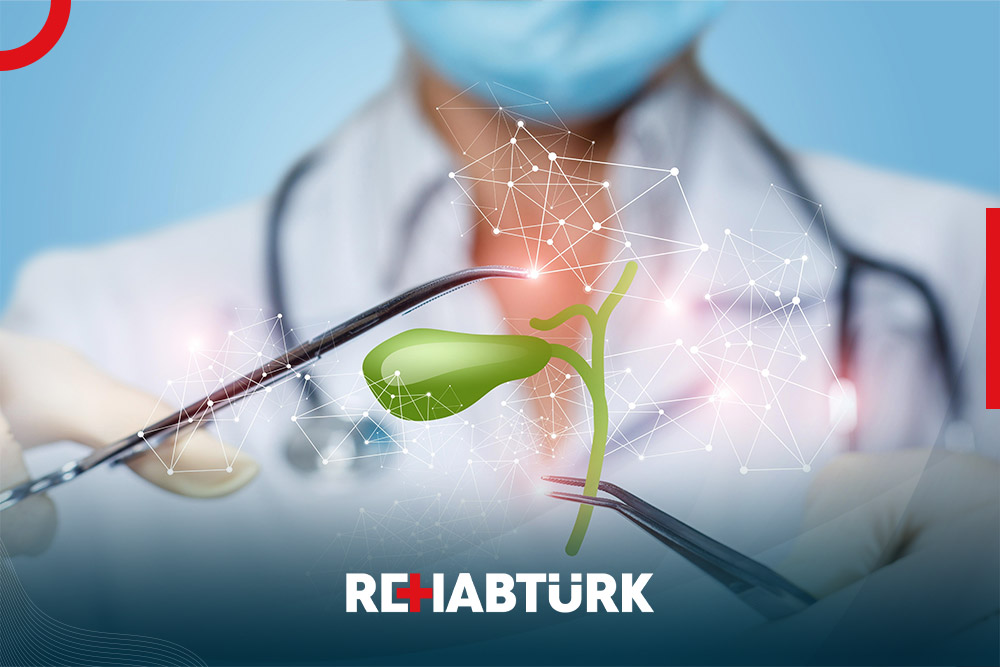Gallbladder cancer treatment in Türkiye
gallbladder cancer
The gallbladder is a small, sac-like organ about 3 inches long and 1 inch wide that lives under the liver and whose job it is to store bile. Bile is a fluid made by the liver after being stored in the gallbladder. Bile is released into the small intestine, and helps digest food. Gallbladder cancer is almost always rare and is almost always adenocarcinoma . It is the type that begins in glandular cells in the lining of organs.
Causes of gallbladder cancer
Doctors don’t know exactly what causes gallbladder cancer. Like all types of cancer, it occurs by mistake known as a mutation in a person’s DNA, and this mutation causes rapid, uncontrollable growth of cells.
Because the number of cells increases rapidly, a mass or tumor forms. If not treated, these cells eventually spread to nearby tissues and to distant parts of the body.
There are symptoms that increase the possibility of developing gallbladder cancer, most of which are related to long-term inflammation of the gallbladder, and the presence of these symptoms does not mean that the person affected by them has cancer, but rather means that the chances of developing it may be higher.
Some of the reasons that increase the risk of infection are:

- Gallstones are small pieces of solid material that form in the gallbladder when the bile juice contains too much cholesterol or bilirubin. As a result, it forms a pigment that breaks down red blood cells.
- When stones block the passages of the gallbladder, called bile ducts, outside the gallbladder or into the liver, the gallbladder becomes inflamed. This is called cholecystitis, and it can be an acute or chronic problem.
- Chronic inflammation due to cholecystitis is the biggest risk factor for gallbladder cancer. According to statistics, gallstones are present with 75 to 90% of people with gallbladder cancer.
But it is important to know that gallstones are very common and their presence does not mean that they are cancerous. According to other statistics, more than 99% of people with gallstones never develop gallbladder cancer.
Some other factors associated with the risk of developing gallbladder cancer are:
- Ceramic gallbladder This occurs when the gallbladder begins to whiten like porcelain because its walls are calcified. This can happen after chronic cholecystitis associated with normal inflammation.
- The occurrence of gallbladder polyps (a type of tumor) and only about 5% of these small tumors are part of the cancerous gallbladder.
- Gender: According to statistics, women get gallbladder cancer four times more often than men.
- Gallbladder cancer usually affects people over the age of 65 and the average age of people is 72 when they find out they have it.
- Ethnic group: In the United States, Latinos, Native Americans, and Mexicans are most likely to develop gallbladder cancer.
- Bile duct problems: Various conditions in the bile ducts that block the flow of bile can cause it to reflux into the gallbladder, causing inflammation that increases the risk of gallbladder cancer.
- Inflammatory scarring of the bile ducts leads to primary sclerosing disease, which is formed due to inflammation of the bile ducts, and this increases the risk of cancer of the bile duct and gallbladder.
- Salmonella bacteria cause typhoid ( typhoid ). People with chronic, long-term infection, with or without symptoms, are at increased risk of developing gallbladder cancer.
- Hereditary cases of previous gallbladder cancer: The risk of infection increases slightly if there is a history of it in the family.
Signs and symptoms of gallbladder cancer
The noticeable symptoms of gallbladder cancer usually do not appear until the disease is very advanced, which is why it has usually already spread to nearby organs and lymph nodes or spread to other parts of the body when it is detected.
When they do occur, signs and symptoms may include:
- Abdominal pain usually in the upper right part of the abdomen.
- Jaundice is a yellowing of the skin and the whites of the eyes due to high levels of bilirubin caused by blockage of the bile ducts.
- A lumpy abdomen occurs when the gallbladder becomes enlarged due to obstruction of the bile ducts or cancer spreads to the liver, and lumps form in the part. right upper abdomen
- Vomiting and nausea
- Weight loss
- Fever
- Abdominal distension
- dark urine
Diagnosis and treatment of gallbladder cancer
Sometimes gallbladder cancer is discovered by chance, sometimes in a gallbladder that has been removed due to cholecystitis or for some other reason. But doctors usually run diagnostic tests because the affected person has symptoms.
Tests that may be used to diagnose the stage of gallbladder cancer and plan treatment include:
- Blood tests and liver function tests show how well the gallbladder and bile ducts in the liver are working and give clues about the cause of symptoms.
- Ultrasound images of the gallbladder and liver are created from sound waves, and it is a simple test that is easy to perform and is usually performed by others.
- CT scan images showing the gallbladder and surrounding organs.
- MRI images show greater detail than other tests.
- Percutaneous cholangiography, which is an X-ray done after injecting a dye into the skin that shows blockages in the bile ducts or liver.
- Endoscopic cholangiopancreatography. In this test, a lighted tube with a camera known as an endoscope is inserted through the mouth and moved into the small intestine. Dye is then injected through a small tube placed into the bile duct, and an X-ray is taken to look for blocked bile ducts .
- Biopsy A small piece of the tumor is removed and examined under a microscope to confirm the diagnosis of cancer and to determine the staging of the cancer, whether and where the cancer has spread outside the gallbladder and is used by doctors to determine the best treatment strategy and determine the outcome.
Gallbladder cancer is staged using a four-stage system and scales from 0 to 4 based on how far the cancer has grown into the gallbladder wall and how far it has spread.
Stage 0 means that the abnormal cells have not spread from the place where they first formed. As for when large swellings occur, which spread to nearby organs, and any tumor spreads or moves to distant parts of the body, then it is stage 4.
- T (tumor) indicates how far the cancer has spread to the gallbladder wall.
- N (nodes) indicates spread to lymph nodes close to the gallbladder.
- M (metastasis) indicates that it has spread to distant parts of the body.
Gallbladder cancer treatment
Surgery can cure gallbladder cancer, but all cancers must be removed, and this is only an option when the cancer is caught early, before it has spread to nearby organs and other parts of the body.
Unfortunately, the statistics confirm that only about 1 in 5 people are diagnosed before the cancer has spread. Chemotherapy and radiotherapy are often used to make sure all cancers are gone after surgery. It is also used to treat gallbladder cancer that cannot be removed.
Cancer cannot be cured or symptoms can be prolonged when gallbladder cancer is advanced, but surgery can be done to relieve symptoms. This is called palliative care. Other types of palliative care may include:
- Pain killer
- Nausea medication
- oxygen
- Placing a tube or stent in the bile duct to keep it open so it can drain
Palliative care is also used when surgery cannot be performed because the patient is not well.
Prevention of gallbladder cancer
Because most risk factors such as age and race cannot be stopped, gallbladder cancer cannot be prevented.
However, following a healthy lifestyle may help reduce the risk of infection. Some tips for a healthy lifestyle may include:
Maintain a healthy weight :
It is a large part of a healthy lifestyle and one of the main ways to reduce the risk of several types of cancer, including gallbladder cancer.
Follow a healthy diet :
Eating fruits and vegetables can help boost your immune system and protect against disease, eating legumes instead of refined grains, and limiting processed foods can help keep you healthy.
Doing sports :
Benefits of moderate exercise include achieving and maintaining a healthy weight and strengthening the immune system.
How can I book for gallbladder cancer treatment in Türkiye?

- Free medical support on the phone: You will have a dedicated representative for your health condition who is always ready to answer your questions.
- Free consultation with a specialist doctor: Your medical representative will consult with a number of doctors and hospitals to find the best possible treatments.
- Free travel visa arrangement: We will contact the embassy in your country to assist you in obtaining a visa to visit Türkiye.
- Free itinerary planning: We will create a schedule for your medical trip to Türkiye.
- Free translation of documents and reports: We will translate medical documents and reports into Turkish on your behalf.
- Free support and monitoring: We will monitor the stages of treatment and be by your side every step of the way.
- Free instant translation: We will be with you during the treatment stages to provide translation between you and the medical team.
- Free accommodation and transportation coordination: We will book accommodation for you and your companions in Türkiye, along with transportation services.
Contact REHABTÜRK doctors for more information about the procedure and to evaluate your medical condition.

